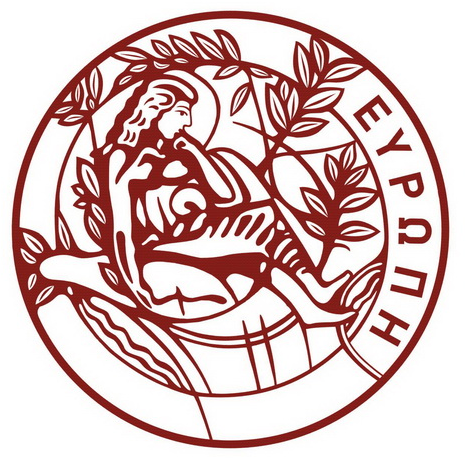Seminars 2009
Monday, December 14th, 2009
- Speaker
- Dr. Leonidas Mouchliadis
- Affiliation
- School of Physics and Astronomy, Cardiff University, UK
- Title
- Exciton-polaritons in Bragg gratings
- Location
- Department of Physics Bldg., Voutes, 3rd floor Seminar Room
- Time
- 16:00
- Language
- English
- Abstract
-
In this work we perform a theoretical study of the peculiar properties of photons travelling inside Bragg gratings, structures of alternating layers of semiconducting materials with slightly different refractive indices. These photons strongly interact with the quanta of polarization of the semiconductor known as excitons, forming new states which inherit qualities from both their photonic and their material components. As superpositions of excitons and Bragg reflected photons, the new states represent the normal modes of the system and can be described in terms of hybrid light/matter "quasiparticles" called Bragg polaritons or Braggoritons. Their dispersion relation is characterized by four branches separated by forbidden energy gaps. It resembles the dispersion of a doublet of microcavity polaritons, formed when excitons inside a quantum well interact with the light field confined between the mirrors of a microcavity surrounding the quantum well. Being a mixture of light and matter, Bragg polaritons acquire an extremely small mass, about a million times smaller than the free electron mass, and transport through the material with velocities that can be reduced up to 10% of the speed of light. While the former property renders Braggoritons excellent candidates for the achievement of macroscopic coherence in a solid state system, the latter can be useful for the observation of extreme nonlinear optical phenomena such as the process of parametric amplifcation.
Monday, January 19th, 2009
- Speaker
- Dr. Achilleas Tsortos
- Affiliation
- Institute of Molecular Biology & Biotechnology, FORTH
- Title
- Biophysical studies in biological mineralization & protein/DNA acoustics
- Location
- FORTH main building, Voutes, Seminar Room 1
- Time
- 12:00
- Language
- English
- Abstract
-
- What is the relationship between a hippopotamus and an ex-president ?
- How do crystals grow in your bones ?
- Can acoustic waves "see" the shape of a DNA strand attached on a surface?
This talk will cover broad research areas such as biological mineralization, apatite crystals, proteins, liposomes and other biomolecules involved in it, as well as biosensor research on DNA molecules at solid/liquid interfaces and viscoelastic properties of thin films; all these from a biophysical point of view.
Wednesday, January 14th, 2009
- Speaker
- Dr. Evangelos Papadopoulos
- Affiliation
- Beth Israel Deaconess Medical Center, Harvard Institute of Medicine, USA
- Title
- Study of the 3D structure and function of biomolecules by NMR and CD
- Location
- Department of Chemistry Bldg., Voutes, Seminar Room 307
- Time
- 12:00
- Language
- English
- Abstract
In this research we have used several techniques and in patricular Nuclear Magnetic Resonance (NMR) for the determination of the solution structure of different biomolecules. Our ultimate goal is the explanation of the function of biomolecules which will allow us a better understanding of biological phenomena and may ultimately provide the opportunity of intervention in biological mechanisms, design better therapies etc.
Thursday, January 8th, 2009
- Speaker
- Asst. Prof. Emmanouil Doxastakis
- Affiliation
- Chemical and Biomolecular Engineering, University of Houston, USA
- Title
- A molecular view of lipid membranes: Stabilization, mechanical properties and transmembrane protein association
- Location
- Department of Physics Bldg., Voutes, 3rd floor Seminar Room
- Time
- 12:00
- Language
- English
- Abstract
The thermodynamic and dynamic properties of lipid membranes present a complex character that is central in biophysical processes. Stabilization and cryopreservation procedures have established the protective role of sugars on cell membranes. Using atomistic molecular simulations and quasielastic neutron scattering experiments the local dynamics of the hydrophilic and hydrophobic part of the membranes can be probed selectively. Elastic scans focusing on lipid tail dynamics display clear evidence of a main melting transition that is significantly lowered in the presence of trehalose, an effect associated with cell preservation. The lipid headgroup mobility is considerably restricted at high temperatures and controlled by the dynamics of the sugar in the mixture.
The lipid lateral organization and the mechanical properties of multicomponent lipid membranes require a view of lipid membranes on considerably larger length scale. Using Monte Carlo simulation techniques and coarse-grained models properties as membrane rigidity can be extracted as a function of lipid composition revealing a non-ideal dependence of properties on composition.
The effect of lipid composition on protein association can be studied using recent advanced algorithms designed to overcome tational limitations imposed by long rotational and translation times observed in lipid membranes. Detailed modeling studies of transmembrane sequences of epidermal growth factor receptors will be presented to provide insight into the dimerization process of a family of proteins that control signal transduction and cell proliferation.


